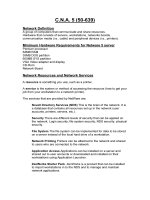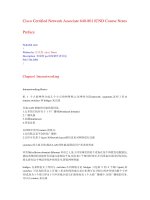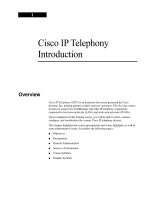Tài liệu Cisco Network Academy Program_ Practices docx
Bạn đang xem bản rút gọn của tài liệu. Xem và tải ngay bản đầy đủ của tài liệu tại đây (83.84 KB, 36 trang )
Best Practices*
Ideas to help you when
implementing Best Practices in the
Cisco Network Academy Program
Best Practices Introduction
Best Practices have always been an important component in the CNAP. Short
explanations were included in the old Teachers’ Guide 1.50 and are now
included in the preface for each semester. The following quote comes from the
preface of Semester 1 version 2.1:
A list of Academy Best Teaching Practices has been compiled. It is
imperative that you use a wide variety of these Best Practices to present
the Cisco Networking Academy Curriculum; these practices have been
demonstrated to be successful with a wide variety of learners. The Best
Practices include Challenges, Design Activities, Graphical Organizers,
Group Work, Journals, Kinesthetic Activities, Lab Exams, Mini-Lectures,
Online Study, Oral Exams, Portfolios, Presentations, Rubrics, Study
Guides, Troubleshooting, and Web Research…Note that lecture (and
PowerPoint or other such leader-led presentations) comprises just a tiny
fraction of how Cisco intends the curriculum to be presented. The subject
matter, our goals for our graduates, and good pedagogy all dictate that a
mixture of these Best Practices be used. Especially important are the
hands-on labs and lab exams, project-based learning (challenges), and
troubleshooting. For example, all Academies are required to have their
students build simple LANs, use multimeters and cable test meters,
terminate Cat 5 Cabling, and perform a Structured Cabling Project as part
of their first semester skill-building.
Feedback from instructor trainees indicates that the greater use of Best Practices
means better comprehension of the concepts. The Best Practices provide a
variety of opportunities to learn as explained through the following:
• “See” the processes through kinesthetic activities;
• Apply the processes through labs, challenges, troubleshooting, presentations,
etc.;
• Obtain the knowledge through online study, mini-lectures, and discussion;
• Think about the processes and concepts through study guides, reflection,
portfolios, and journals;
• Organize the components and ideas through graphical organizers,
presentations, and study guides; and
• Discuss ideas and concepts with others through group work.
This handout contains additional information to assist you in understanding and
applying the Best Practices. The handout has three components.
The first component has a short explanation of Bloom’s Taxonomy as it is applied
to CNAP.
The second component is a chart that demonstrates the main and secondary
purposes of each Best Practice as well as the class structure generally used
during implementation.
The third component is an expanded explanation of most of the Best Practices.
Each explanation has a description, a brief statement of research, some
implementation ideas and a rubric for assessing the quality of the trainee/student
work.
• The following Best Practices are included:
• Challenges
• Graphic Organizers
• Group Work
• Journals
• Kinesthetic Activities
• Lab Exams/Activities
• Mini-Lecture
• Portfolios
• PowerPoint Presentations
• Presentations
• Reflection
• Rubrics
• Troubleshooting/problem solving
It is important that the CATC and Regional Academy instructors use and
understand the Best Practices, as they are the link to the Local Academy
instructors who work directly with students. The students will have a more
effective educational opportunity if Best Practices are used to assist their
learning.
The handout is a draft and a beginning of the support that will be offered
regarding Best Practices. Any suggestions or comments are welcome.
Bloom’s Taxonomy
Bloom’s Taxonomy is simply a hierarchical framework designed by Benjamin
Bloom that instructors and trainers can use to analyze and develop questions
and activities that encourage different types of thinking. They may be used as
guidelines for developing assessments that measure multiple levels of thinking.
The goal is to include questions of differing levels in each lesson and to help
students improve their critical thinking skills at the top levels of the hierarchy.
The six levels beginning with the lowest level of thinking are as follows:
• Knowledge
• Comprehension
• Application
• Analysis
• Synthesis
• Evaluation
Definitions are included for each level with examples from the networking
curriculum.
Level 1 Knowledge
Knowledge allows students to define, describe, list, identify, label, outline, select
and state facts regarding content. The objective is to have students know
common terms, specific facts, methods and procedures, basic concepts and
principles.
Examples:
• List the full names for the acronyms-ARP, RARP, IOS, RIP, IGRP, ACL,
ISDN, etc.
• Identify how many bits comprise an IP address. (Sem 1)
Level 2 Comprehension
Comprehension allows students to paraphrase, defend, estimate, explain,
distinguish, give examples, infer, predict, or summarize. It requires the ability to
grasp the meaning of material, understand facts and principles, interpret verbal
material, and justify methods and procedures.
Examples:
• Distinguish between standard and extended Access Control Lists (Sem 3)
• Give examples of IOS commands useful for examining different router
components (Sem 2)
• Paraphrase the function of each of the 7 layers (Sem 1)
• Classify 191.52.7.1 as either a class A, B, and C IP address (“A”s begin with
0 to 127; “B”s begin with 128 to 191; “C”s with 192 to 223. (Sem 1)
Level 3 Application
Application allows students to demonstrate, relate, show, modify, prepare, solve,
give examples, manipulate, or generalize. It requires them to use ideas and
material they have learned in new situations, apply theories to practical
situations, and demonstrate correct methods or procedures.
Examples:
• Demonstrate the construction of a patch cable (Sem 1)
• Modify the following IOS statement so that it assigns 193.1.7.5 as the static
route for all packets on 199.4.5.0: ip route 193.1.7.5 255.255.255.0 199.4.5.0
(Sem2)
Level 4 Analysis
Analysis allows students to brainstorm, point out, differentiate, separate, and
discriminate. It’s the purpose of breaking material into its components so that the
organizational structure is understood; recognizing unstated assumptions and
logical fallacies; distinguishing between fact and inference; and evaluating
relevancy of data.
Examples:
• Brainstorm the problems that can cause a PING to fail (Sem 2)
• You are troubleshooting the 5-router network. Distinguish between
observable network symptoms and what problems you might infer are
causing those symptoms.
Level 5 Synthesis
Synthesis allows students to combine, devise, compose, organize, plan,
reorganize, revise, rewrite, and generate. It involves the ability to put parts
together to form a whole item; write a well-organized essay; write creatively;
integrate learning from different areas in to a plan for solving a problem or form a
new scheme for classifying ideas and events.
Examples:
• Generate a design for an elementary school LAN. (Sem 3) Generate a design
for a School District WAN. (Sem 4)
• Plan a school-wide structured cabling installation for Net Day. (Sem 1)
• Compose a subnetted IP address scheme for a class C network (192.18.9.0)
which leads to
Level 6 Evaluation
Evaluation requires students to appraise, compare, contrast, criticize, support,
conclude, or interpret. It’s the ability to judge the value of material for a given
purpose and to evaluate logical consistency of written material and the adequacy
of conclusions. Judgements should be based on specific criteria given by the
instructor of determined by the students.
Examples:
• Your compnay has decided to use Category 6 UTP (instead of CAT 5, 5e, or
7) – support their decision.
• Interpret the following result of a “show ip interface command: Serial 0 is
administratively down; line protocol is down”.
• Contrast the metrics used by RIP with the metrics used by IGRP (Sem 2).
• Use a rubric to compare the TCS LAN and WAN solutions designed by the
class groups. (Sem 3 and Sem 4)
• Compare the following two LAN technologies for use in a high school
environment on a limited budget: 10BASE-T Ethernet and 100BASE-TX Fast
Ethernet (Smes 1 and 3).
• Compare the following two WAN technologies for a high school on a limited
budget: ISDN and Frame Relay. (Sem 4)
Best Practices
Challenges
Description:
Challenges are problem-based labs or projects, advocated by AAAS Project
2061 (a science education reform project). These exercises are the opposite of
cookbook, or step-by-step, labs. Instead, they encourage students to work on
their own to develop solutions to various problems or challenges.
The challenges vary in content and duration (from fifty minutes to three weeks),
and are comprised of two basic parts. First, the lab asks students to solve a
given problem. Second, it asks the students to create a product. For example, a
simple 50-minute challenge lab for the first semester might be titled “Make a
Patch Cable that Works Successfully”. A three-week challenge that could teach
more complex tasks might be called “Wire the School Computer Lab”.
Research:
While little research deals with challenges per se, many of the components that
make up a “challenge” have been thoroughly studied and have consistently
shown possible results. Research shows that the most effective learning
patterns occur when students are closely involved with the curriculum such as
happens when an assignment translates theoretical learning to a “hands-on”
setting. Tasks that require students to do the following:
• apply previously mastered basic learning to a new situation
• use both analysis and synthesis to create a workable product
• evaluate both the process and product
• are demanding and allow the assessment of higher order thinking skills.
Challenges are a part of the category of active learning that has been explored
for use with almost any subject matter and with any population. Numerous
strategies have been devised to successfully promote active learning with any
age level, but is most successful with older children and young adults.
Implementation:
The degree of independence in solving challenges should vary according to the
level of knowledge and the complexity of the task. Begin using the less complex
and shorter challenges with the students. Have them work in pairs until they are
familiar with the process and gain confidence in their skills. Make certain that
they record key ideas in their journals as a record of their progress. After each
challenge, discuss the process and what they learned in completing it. Have
them identify strategies that would be helpful when they complete the next
challenge.
As students gain in knowledge there should be less guidance and more
individual solving of the problem. When they become proficient, the students
could be placed in competitive teams to solve a challenge. This is especially
appropriate during Semesters 2, 3 and 4.
Students can record information regarding their success and failures in solving
challenges in their journals. Periodically, have the students review their journals
for comments regarding challenges. Have them look for evidence of growth in
solving them, improved strategies, and general increase in content knowledge.
Some students may wish to include their challenges in their portfolios.
Rubric:
A quality challenge solution will meet the following criteria:
• Use a problem solving format
• Use a logical process
• Solve the challenge correctly
• Demonstrate the thinking process
• Show evidence of critical thinking including analysis, comparison, synthesis
and evaluation
• Show thorough understanding of content
• Use references effectively (web research or instructional manual)
Best Practices
Graphic Organizers
Description:
These terms refer to a large group of visual tools (diagrams and schematics)
used to represent concepts and ideas. They are implemented to facilitate
comprehension of expository text. They seek to replicate the patterns used by
the brain to recall linked information or detail.
Some types of graphic organizers include semantic maps, summary sheets,
concept maps, semantic feature analysis grids, story maps, structured note
taking, PERT charts, Venn diagrams, webbing, main ideas, cause and effect
frameworks, fact/opinion frameworks, classification frameworks, flowcharts, story
mapping, brainstorming webs, pictures maps and graphs.
Those especially useful in electronics and engineering are cluster diagrams,
problem-solving matrices, flowcharts, block diagrams, topological diagrams,
voltage versus time graphs, voltage versus frequency graphs, layered
communication diagrams, frame format diagrams, and standard internetworking
symbols. These graphic organizers are discussed in detail in the Instructors'
Guide.
Research:
Research indicates that the use of organizers benefits all learners in all content
areas. In addition, specific testing was completed to study visually/spatially
talented and visually/spatially challenged student learners to determine who
benefited most as a result of using visual tools. It was found that both groups
benefited. A secondary outcome was a more positive outlook toward the subject
matter with greater gains by the challenged learners. Instructors have indicated
in studies that their instruction was improved through the use of graphic
organizers
Implementation:
Each type of organizer has its unique purposes and uses. These are described
for ten of the organizers in an in-depth explanation in the instructors' guide. One
main guide is that the graphical organizer chosen should be congruent with the
instructors' purpose and enhance the concepts of the topic being discussed.
Organizers can be copied and given to each learner or presented electronically
for them to sketch. Some instructors complete the organizer on a chart,
whiteboard or poster while explaining the information. This provides a visual
model for learners to copy and should be used when first using organizers or
when presenting exceptionally complex concepts.
Learners can use the graphical organizers to review with a partner or group
before a project or a test. These could be placed in their journal or portfolio.
The most effective graphic organizers have been those made by the instructor for
the specific material being presented. Instructors and learners can often design
a graphic organizer together. Certainly, critiquing a completed organizer for its
effectiveness for learning the content encourages learners to design their own
tools for understanding new content.
Rubric:
An effective graphic organizer should meet the following criteria:
• Provides an appropriate and logical visual for the content and concepts
presented
• Shows relationships among concepts
• Utilizes a design that is easily understood by all learners
• Focuses the learners in the content through questions and/or clearly stated
objectives
• Results in a organized plan, processes, and/or a product that demonstrates
learning
• Provides for analysis and redirection of learning
Bests Practices
Groupwork
Description:
Groupwork refers to using a variety of trainee/student groups to enhance
learning. Learners can be grouped for reviewing, questioning, learning content,
doing performance labs, designing projects, assessing their learning and other
suitable tasks. Within cooperative teams, individuals seek outcomes that are
beneficial to themselves and other members of the group. Working together,
students and trainees are able to maximize their own and each other's learning.
Groups can be pairs or partners, small groups of 3-5 or larger, teams or
competitive teams, large groups of 9 to 15, and whole class groups.
Research:
Numerous research studies have been conducted on ways to improve learner
motivation, attendance, and academic growth through grouping for learning
activities. Cooperative and integrated learning groups have been found to
enhance inter-group relations and team building. For the Networking program,
the ability to work together is beneficial to future employment.
Prior to the 90’s, it was generally believed that the most effective classes were
those that had a low number of students. Current educational philosophers look
instead to styles of grouping within the classroom where dimensions such as
group problem solving has been measured more effective than other modes of
instruction for higher order thinking tasks. Various modes of small groups are
shown to make a significant difference in learning patterns. Studies in Great
Britain, Canada, Australia, and the United States have revealed the same results
related to the benefits of grouping for learning.
Implementation:
Trainees and student learners can be assigned to groups or they can choose
their own group. As a class, the rubric (criteria) for effective groupwork should be
discussed prior to the activity. The difference between individual and group effort
should be emphasized. It is useful to discuss group roles such a leader,
recorder, timer, etc.
Have the groups clarify the task or assignment to be accomplished. During the
group work, the instructor can move around the classroom to answer questions,
assist in maintaining focus, and ensure that all group members are actively
engaged.
After the group presents projects, plans or ideas, use the rubrics to assess how
well the group process worked. Group work for organizing, planning,
researching, and focusing is beneficial. Individual responsibilities for learning,
presenting, producing, can be established with specific criteria for the
presentation or product that provides evidence of the individual learning.
Rubrics:
Group Effort
• Utilizes individual strengths to enhance the process
• Reaches consensus through negotiation and compromise
• Collaborates effectively and efficiently
• Utilizes resources and materials to maximum advantage
• Keeps within timelines and meets all set deadlines
• Reflects on progress, process and product
Individual Effort
• Performs multiple roles and responsibilities within the group
• Respects other members feelings, abilities, opinions, contributions
• Contributes equitably within the group
• Enhances the strength of the group
• Utilizes resources and materials effectively and efficiently
• Meets set deadlines
• Reflects on progress, process and product
(Rubrics are also available for group planning and group problem solving.)
Best Practices
Journals
Description:
Typically, a journal is a paper, bound, composition book in which pages are not
added or subtracted, but dated. The purposes of a journal are to document the
process and progress of learning and work and to develop a reference of
solutions that have worked in the past.
Engineering journals come in part from patent law. Most corporations have their
technical employees keep a journal (dated, signed, bound and kept in ink) to
resolve patent issues. It is a legal document and may be used in audits.
In the field of networking, engineers keep journals in which they record their
thoughts regarding the many activities in which they are engaged. Journals in
general are a record of an individual’s thoughts regarding a specific topic. These
thoughts, overtime, allow the learner to analyze and chart his/her progress in
understanding the topic. The journal will include events that failed as well as
those that succeeded.
The types of journal entries most applicable for Networking Academies’ students
include:
• daily reflections
• troubleshooting details
• lab procedures and observations
• equipment logs
• hardware and software notes
• router configurations
• contacts & resources
• questions
• designs
While the journal becomes much more important as the students do more
network design and installation work, good habits can be developed by starting
with a journal the first day of the first semester.
Research:
Journals were "reinvented" within the last few decades not for the value of the
content, but for the value to the author as a response to the prevailing attitudes of
learners that were reported by researchers. Learners felt that the success or
failure of their learning program was outside of their control. Assessments were
done "on them"--their role was passive rather than as an active learner.
Students were found to lack a sense of ownership, were not self-directed, lacked
the ability to self-reflect and exhibited low expectations of themselves. Where
these attitudes were most prevalent, it was noted that students were excluded
from the conferencing, the portfolio selection, and the criteria setting processes.
Some of the strategies implemented to address the problem were using
alternative assessments, increasing student ownership and responsibility and
creating opportunities for student self-assessment. This came about largely
through the use of journals where they were recognized as a powerful tool both
for content and process.
Implementation:
Each student is responsible for maintaining his/her journal. Often, instructors
may provide a specific time in class for the students to make notes in their
journals. Students may also record their ideas as they read, listen, or complete
activities. For example, during a mini-lecture, the students may record analogies
that help them understand a concept. During a lab activity they may record their
procedures with results. After an exam, they may write the concepts that they do
not understand. Questions that they want to explore may be written at any time.
Students may use their journals to assist in reviewing for an exam. Periodically,
they may review their journals to analyze their progress in learning the content
and record reflections.
Students who are able to develop the habit of using a journal may be more
successful in networking or whatever technical career is in their future.
Rubric:
A quality journal will meet the following criteria:
• Demonstrate organizational skills
• Use real life examples and analogies
• Show independent thinking by providing own solutions; synthesizing major
concepts; and demonstrating connections between major concepts and
content
• Use sketches, diagrams, analogies and notes to clarify meaning
• Include important content
• Can be used to solve problems and as a resource for further learning
• Include reflections and evidence of self-analysis
• Cross-references with other problems, solutions, and ideas in the journal









